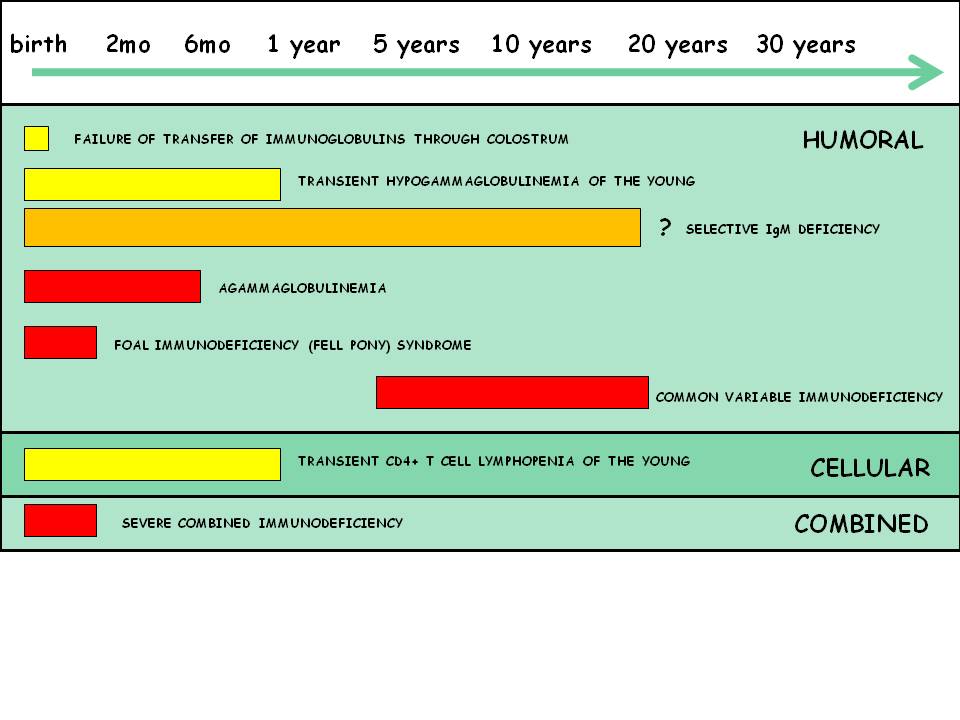Immunodeficiencies in Horses
Immunodeficiency is a rare disorder of the immune system that results in failure to build protection against pathogens. The most common clinical indication of an underlying immunodeficiency is recurrent infections with frequent treatment failures.
Clinical conditions that may indicate immunodeficiency include:
- two or more episodes of pneumonia within 1 year;
- infections with opportunistic organisms;
- multiple sites of infection (pneumonia + sinusitis);
- recurrent pyodermatitis, deep skin or organ abscesses;
- single episode of meningitis or osteomyelitis;
- two or more months on antibiotics with little or no affect;
- failure to gain weight or grow normally;
- recurrent infections with a history or primary immune deficiency in the blood line.
In equine neonates, the clinical recognition of immunodeficiency may not be obvious because of the common presentation of failure of passive transfer of immunoglobulin and infection in this age group. However, infections with opportunistic organisms (e.g. Cryptosporidium parvum, Pneumocystis jirovecii, Candida spp., adenovirus) should alert for an immunodeficiency condition. In contrast, foals with recurrent respiratory infections at a later age (3-6 months of life) could present a delay in the development of their immune system, which increases their susceptibility to pathogens. In the adult horse, stress plays a significant role in predisposition to infections that can be managed with rest and supportive treatment; however, recurrent bacterial respiratory infections or meningitis are common manifestations of underlying immunodeficiencies.
Immunodeficiencies can affect different elements of the immune system:
- B cells (humoral immunodeficiency);
- T cells (cellular immunodeficiency);
- B and T cells at the same time (combined immunodeficiency);
- phagocytes;
- or complement factors.
Classification of Immunodeficiencies
Independent of a primary or secondary cause of immunodeficiency, recurrent infections and fevers are common to all types of immunodeficiency because they translate the presence of an infection. However, it is the type of organism causing the disease that suggests the faulty mechanism: susceptibility to encapsulated bacteria occurs in humoral immunodeficiencies, whereas intracellular pathogens may cause disease in cellular immune disorders. Another important factor to keep in mind is that infection alone does not support a disorder of the immune system, and non-immunologic causes of infection should always be considered, importantly conditions that disrupt pathogen clearance mechanisms (e.g. viral infections, catheterizations, allergies, auto-immunity, lymphoma/lymphosarcoma).
Primary immunodeficiencies are congenital processes associated with a genetic defect. Primary immunodeficiencies comprise quantitative or qualitative defects in cells or components of the immune system that impair immune cell development, function or structure. Most disorders occur during cell differentiation in the bone marrow due to single or complex mutations/deletions in essential developmental genes. Therefore, the manifestation of these disorders is more frequently observed in the young than in adult horses but it does not exclude the latter (see CVID below). In the young, the manifestation may coincide with the time of low circulating colostrum-derived antibodies.
Secondary immunodeficiencies may occur at any time in life. These are acquired disruptions in the immune function that reduce the ability of the system to fight against opportunistic and/or pathogenic organisms. Conditions that may predispose to secondary immunodeficiencies include immunosuppressive treatment (e.g. steroid therapy), stress, virus diseases, tumors, metabolic/endocrine diseases, aging, auto-immunity and malnutrition. In secondary immunodeficiencies, the disturbance may be transient or chronic, and one or several elements of the immune system may be affected at the same time. This group of immunodeficiencies also includes self-limited or transient conditions, often observed in the young.



